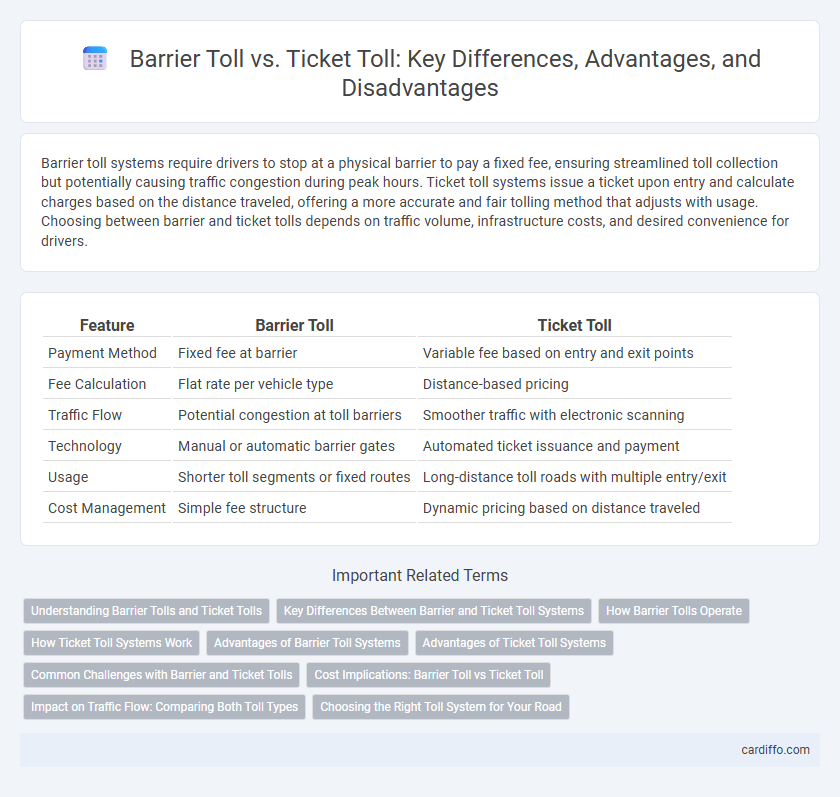Barrier toll systems require drivers to stop at a physical barrier to pay a fixed fee, ensuring streamlined toll collection but potentially causing traffic congestion during peak hours. Ticket toll systems issue a ticket upon entry and calculate charges based on the distance traveled, offering a more accurate and fair tolling method that adjusts with usage. Choosing between barrier and ticket tolls depends on traffic volume, infrastructure costs, and desired convenience for drivers.
Table of Comparison
| Feature | Barrier Toll | Ticket Toll |
|---|---|---|
| Payment Method | Fixed fee at barrier | Variable fee based on entry and exit points |
| Fee Calculation | Flat rate per vehicle type | Distance-based pricing |
| Traffic Flow | Potential congestion at toll barriers | Smoother traffic with electronic scanning |
| Technology | Manual or automatic barrier gates | Automated ticket issuance and payment |
| Usage | Shorter toll segments or fixed routes | Long-distance toll roads with multiple entry/exit |
| Cost Management | Simple fee structure | Dynamic pricing based on distance traveled |
Understanding Barrier Tolls and Ticket Tolls
Barrier tolls require drivers to stop at a designated point and pay a fixed fee, enabling straightforward toll collection and efficient traffic management. Ticket tolls involve issuing a ticket upon entry and calculating the toll based on the distance traveled when exiting, allowing for variable pricing that reflects actual road usage. Both systems optimize revenue collection but differ in operational complexity and convenience for drivers.
Key Differences Between Barrier and Ticket Toll Systems
Barrier toll systems utilize physical gates that require vehicles to stop and pay a fixed fee before proceeding, streamlining traffic flow through automated barriers or attendants. Ticket toll systems issue entry tickets and calculate charges based on the distance traveled, allowing variable pricing and accommodating longer journeys with more precise toll assessments. The primary difference lies in barrier tolls charging a flat rate at specific points, while ticket tolls offer distance-based fees determined upon exit.
How Barrier Tolls Operate
Barrier tolls operate by requiring vehicles to stop at a physical toll booth where a fixed fee is collected before proceeding, enabling straightforward revenue collection based on vehicle class or type. This system simplifies toll enforcement and reduces evasion by controlling access at entry or exit points on toll roads. Vehicle identification technologies such as license plate recognition or RFID tags may be integrated to streamline the payment process and enhance traffic flow.
How Ticket Toll Systems Work
Ticket toll systems operate by issuing a ticket with entry details when a vehicle enters the toll road, recording the entry point and time. Upon exit, the driver presents the ticket at a toll booth where the system calculates the toll fee based on the distance traveled or time spent on the toll road. This method enables variable toll charges, promoting fairness and efficiency compared to flat-rate barrier tolls.
Advantages of Barrier Toll Systems
Barrier toll systems offer faster vehicle processing by minimizing stops, thus reducing congestion and improving traffic flow compared to ticket tolls. These systems enhance operational efficiency with simpler infrastructure and lower maintenance costs, eliminating the need for extensive ticket management. Barrier tolls also provide more accurate toll collection and better enforcement against toll evasion due to their controlled entry and exit points.
Advantages of Ticket Toll Systems
Ticket toll systems offer precise distance-based billing by issuing tickets upon entry and calculating charges based on exit points. This method ensures fair pricing tailored to actual road usage, reducing congestion by minimizing unnecessary stops. Enhanced revenue accuracy and improved traffic flow are key advantages over barrier toll systems, which typically charge a fixed fee regardless of travel distance.
Common Challenges with Barrier and Ticket Tolls
Barrier toll systems often face congestion due to physical stops, leading to increased wait times and higher operational costs for maintenance of gates and attendants. Ticket tolls present challenges in ticket management, such as loss or damage, causing payment disputes and delays at exit points. Both systems struggle with revenue leakage from evasion and require robust monitoring and enforcement mechanisms to ensure toll compliance.
Cost Implications: Barrier Toll vs Ticket Toll
Barrier toll systems typically involve flat-rate charges collected at fixed points, which can lead to predictable but sometimes higher overall costs for short-distance travelers. Ticket toll systems calculate fees based on the exact distance traveled, offering potential savings for longer journeys but possibly increasing administrative expenses due to ticket issuance and processing. Choosing between barrier and ticket toll systems depends on balancing the simplicity of flat-rate collection against the precision and fairness of distance-based pricing.
Impact on Traffic Flow: Comparing Both Toll Types
Barrier tolls create sudden stoppages at fixed points, causing congestion and longer wait times during peak hours. Ticket tolls allow vehicles to maintain a steady speed by collecting entry and exit information electronically, reducing bottlenecks and improving overall traffic flow. Studies show that ticket toll systems decrease average delay by up to 30% compared to barrier tolls on busy highways.
Choosing the Right Toll System for Your Road
Barrier toll systems require vehicles to stop and pay at physical toll booths, providing straightforward fee collection but potentially causing traffic delays during peak hours. Ticket toll systems issue entry tickets and collect payment based on distance traveled, optimizing traffic flow and enabling variable pricing for different road segments. Selecting the right toll system depends on balancing traffic volume, operational costs, and desired revenue models to ensure efficient road usage and user convenience.
Barrier Toll vs Ticket Toll Infographic

 cardiffo.com
cardiffo.com